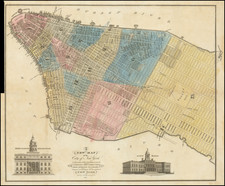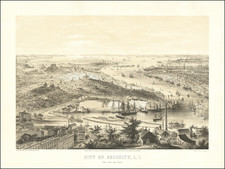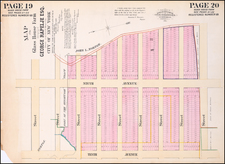The South Street Seaport of Lower Manhattan.
Wonderful original manuscript survey map of the area around what is now the South Street Seaport in Lower Manhattan, drawn by City Surveyor George B. Smith in 1824, and resurveyed in 1825.
The map is oriented with northwest at the top. It is bounded by present-day Fletcher Street (which may have recently been covered up by two skyscrapers), Front Street, South Street, and John Street (here Burling Slip). This neighborhood is adjacent to the seaport historic district that still maintains its 19th-century character, in stark contrast to most of the rest of lower Manhattan. In the 1820s the neighborhood was one of the most active and important commercial zones in the world.
The map shows several properties on the block, including those owned by John Jackson, T. Polhemus, Abraham Valentine, and S.B. Munn. The map was made to illustrate a strip of land that was in the estate of Teunis Tiebout, including a three-story brick storefront and a right of wharfage.
Despite the fact that the map was drawn in 1825-25, Teunis Tiebout may well have been an early 18th-century, second-generation Dutch New Yorker. The most extensive biography appears in The Ancestry and Posterity of Cornelius Henry Tiebout of Brooklyn, 1910 (pages 14-17):
Theunis Tiebout, son of Jan Tibout and his wife Sara Vander Vlucht, was a carpenter, contractor and builder and a man, evidently, of considerable political influence, as he had charge of the building of many of the public works. In 1712 he offered to "erect a horsemill in the city never before seen in these parts." There is no record of his proposition being accepted, but the Proceedings of the Common Council of New York show that his services were in frequent demand, and great confidence was reposed in his skill and judgment as a builder. In Volume III of these Proceedings, under date of July 30, 1717, it is shown that "Unto Theunis Tiebout and his son Hendrick were paid twenty-one pounds and fifteen shillings for construction of the cupola on the City Hall."









![[Brooklyn] Manhattan Beach Estates - Map of Property situated in the Borough of Brooklyn](https://storage.googleapis.com/raremaps/img/small/80730.jpg)



![Southeastern New York [with inset] Vicinity of New York](https://storage.googleapis.com/raremaps/img/small/101125.jpg)
![(Pocket Map) Colton's New York City, Brooklyn, Jersey City, Hoboken Etc [G. Woolworth Colton's New York City Jersey City, Hoboken, Brooklyn]](https://storage.googleapis.com/raremaps/img/small/85405.jpg)